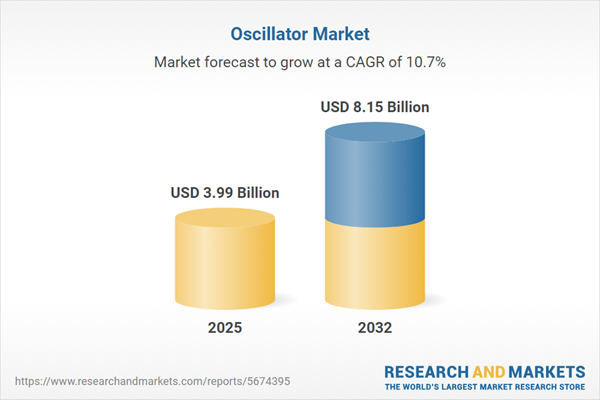Speak directly to the analyst to clarify any post sales queries you may have.
The oscillator market is evolving rapidly as organizations address shifting compliance requirements while embracing sector-wide transformation. Senior decision-makers are prioritizing resilient sourcing strategies and advanced technologies to ensure uninterrupted supply and robust regulatory navigation.
Oscillator Market Snapshot
The oscillator market continues to build momentum, fueled by growing need for advanced timing solutions that are central to today’s critical digital infrastructure. Electronic components such as oscillators underpin telecommunications and industrial automation, with sector modernization accelerating demand for precise frequency control. As companies advance their digital and automation networks, timely response to evolving technical and regulatory requirements is essential for maintaining competitive positioning and adapting operations effectively.
Oscillator Market Scope & Segmentation
This report provides senior leadership with actionable insight into factors influencing the oscillator market, supporting sound decisions on supply chain planning, investment priorities, and compliance frameworks.
- Sales Channels: Assessing direct sales, distributor-led models, and digital procurement approaches helps identify optimal risk mitigation strategies and enhances supply continuity for critical electronic components.
- Technology Types: Reviewing analog, digital, and programmable oscillator solutions enables businesses to align deployments with distinct operational contexts and industry requirements.
- Frequency Ranges: Addressing a full spectrum, from low-frequency configurations vital in process automation to microwave bands essential for telecommunications and advanced industrial control systems.
- Product Types: Examining a broad range, including fixed, variable, and sweep oscillators, as well as waveform generators and specialized LC, RC, voltage-controlled, and YIG models, each tailored to specific system objectives.
- Applications: Meeting industry demands across aerospace, defense, automotive connectivity, medical devices, telecom, and automation sectors, with a focus on system reliability and seamless integration.
- End Users: Considering procurement impacts for government, automotive, semiconductor, healthcare, and telecommunications stakeholders as they navigate shifting regulatory environments and market trends.
- Geographic Regions: Comparing opportunities and compliance needs across the Americas, Europe, Middle East & Africa, and Asia-Pacific, with attention to regional growth dynamics.
- Company Analysis: Benchmarking strategies and positioning of leading firms such as Murata Manufacturing, Kyocera, Seiko Epson, TXC, Abracon, Nihon Dempa Kogyo, Silicon Laboratories, CTS Corporation, Fox Electronics, and Rakon.
Oscillator Market: Key Takeaways for Decision-Makers
- Integrated oscillator solutions facilitate streamlined system architecture and operating efficiency for scalable digital networks in critical industrial and telecom settings.
- Advancements in miniaturization and reduced power draw support broader use in both industrial and remote applications, expanding potential operating environments amid resource constraints.
- Programmable and hybrid oscillator types enable leaders to address compliance complexities and regulatory adaptation through versatile system configurations for multi-sector adoption.
- Collaboration between manufacturers and research bodies accelerates innovation cycles, expedites response to emerging product needs, and supports agile market adaptation.
- Strengthening supplier networks and giving preference to local sourcing enhance supply chain stability and minimize risks caused by regulatory changes and external disruptions.
Tariff Impact
New U.S. tariffs are raising raw material expenses for the oscillator sector. Companies are increasingly shifting production to domestic sites and boosting module capacity to manage cost pressures. As these trade conditions evolve, organizations focusing on regional supply chains and strong contract controls improve their operational resilience and adaptability.
Methodology & Data Sources
This research leverages direct interviews with industry experts, technical assessments, and continual patent tracking. All conclusions are cross-referenced with supplier validations, impartial laboratory outcomes, and association benchmarks to provide C-suite decision-makers with dependable market guidance.
Why This Oscillator Market Report Matters
- Delivers essential insight for executive teams seeking to anticipate technology changes and advance procurement efficiency in the oscillator industry.
- Empowers proactive risk management and adaptable supply chain solutions to address regulatory and trade disruptions confidently.
- Supports optimal resource planning and drives ongoing innovation so senior leaders can enhance organizational agility in shifting compliance environments.
Conclusion
This analysis equips executives with the information needed to refine strategies and strengthen operational performance, enabling them to capitalize on new opportunities as the oscillator sector and its regulations continue to evolve.
Additional Product Information:
- Purchase of this report includes 1 year online access with quarterly updates.
- This report can be updated on request. Please contact our Customer Experience team using the Ask a Question widget on our website.
Table of Contents
3. Executive Summary
4. Market Overview
7. Cumulative Impact of Artificial Intelligence 2025
Companies Mentioned
The companies profiled in this Oscillator market report include:- Murata Manufacturing Co., Ltd.
- Kyocera Corporation
- Seiko Epson Corporation
- TXC Corporation
- Abracon LLC
- Nihon Dempa Kogyo Co., Ltd.
- Silicon Laboratories, Inc.
- CTS Corporation
- Fox Electronics, Inc.
- Rakon Limited
Table Information
| Report Attribute | Details |
|---|---|
| No. of Pages | 188 |
| Published | October 2025 |
| Forecast Period | 2025 - 2032 |
| Estimated Market Value ( USD | $ 3.99 Billion |
| Forecasted Market Value ( USD | $ 8.15 Billion |
| Compound Annual Growth Rate | 10.7% |
| Regions Covered | Global |
| No. of Companies Mentioned | 11 |









